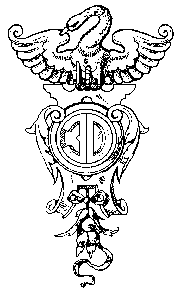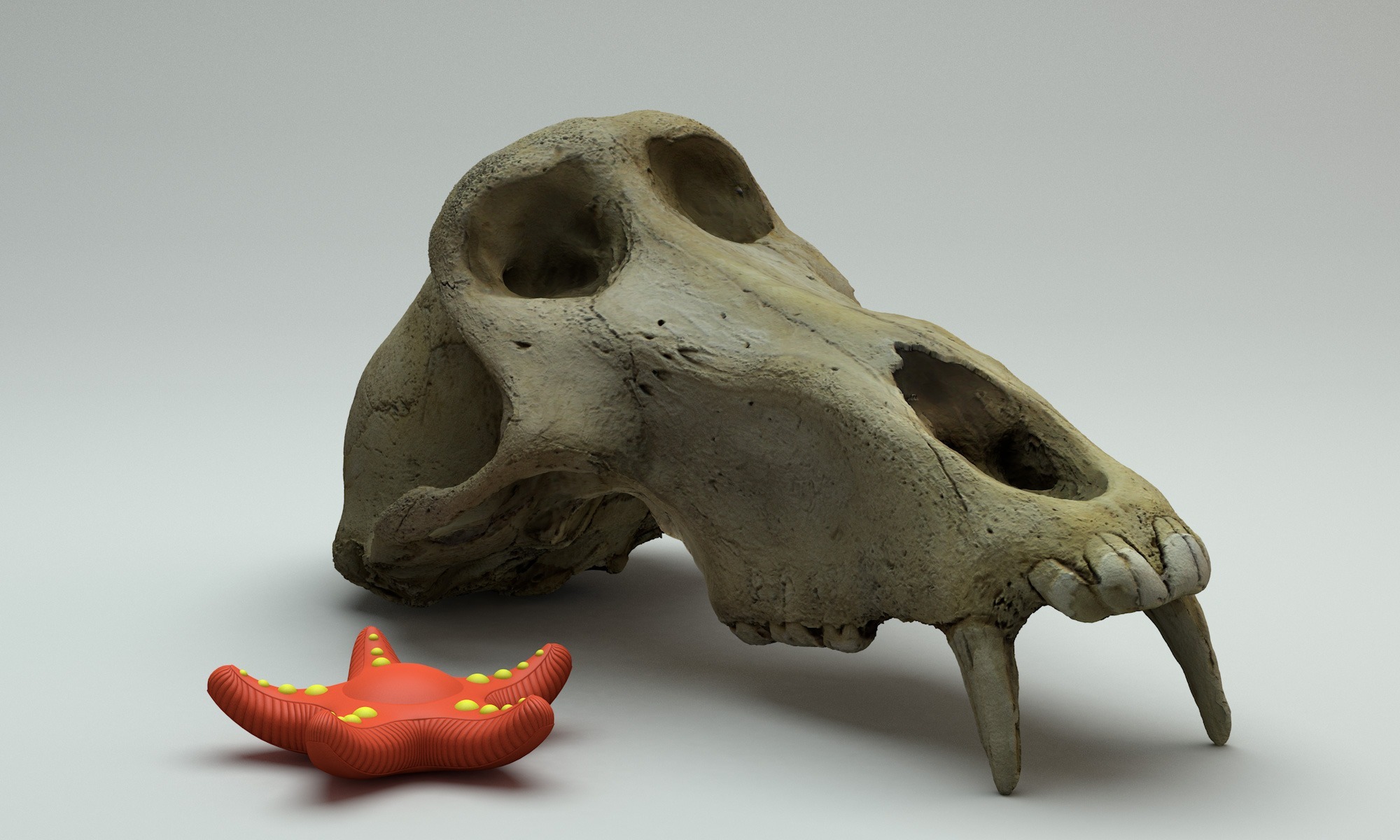Stereoscopic Anamorphosis
Instructions for viewing
To cause the exceptional effect of this three-dimensional view of Neuschwanstein first of all you lay the picture horizontally in front of you. Holding the red filter of the color spectacles to the left eye and the green filter to the right one, you observe the image from a diagonal angle of about 45°. It is correctly seen when the representation raises straight upright out of the plane. The tallest — octagonal — tower then roughly measures 11 cm.
Neuschwanstein

The illustration shows the castle from southern direction from above. In front on the left you catch sight of the slim palas, which is following the bend of the ridge with its characteristic curve. On its western front, the double leveled balcony of the throne room becomes visible, beneath a door which was intended to lead to a platform, which hasn’t been ever completed. Above the balcony stands the statue of a knight with shield and lance on the high gable, flanked by two small corner turrets.
On the northern side of the palas, above the roof and its chimneys and dormer windows, the octagonal tower raises like a minaret. Right from the round front-tower, on ground level, there is the terrace of the kitchen and, on third level, balcony and oriel to the King’s bedroom. At the eastern facade of the palas one of the octagonal bay turrets is visible and, at the gable roof, a lion for finish.
To the east the kemenate is attaching, not finished until 1892. In its steeply sloping foundations you can recognize the bridging of a cleft between the crooked stairs tower and the jutting risalto. Behind the kemenate the upper courtyard is extending, on whose apse-like balustrade you still can discover the contours of the choir of the originally planned chapel. As this section of the castle — with an overtopping keep —, however, has not been finished after the death of the King, the view on the northern parts of the building remains free.
The palas is connected with the quadrangular tower with its very wide platform by a slim building, in which the three-leveled knights’ house is integrated. The partly covered stairs in front of its entrance lead to the first floor of the palas. In the northeast the lower courtyard is bordered by another connecting building with a staircase in front and by the gate and its corner towers. This section of the building stands out because of its reddish colored stone; it has been finished first and was also temporarily inhabited by the King. Through the archway the visitors get into the museum today.
Neuschwanstein and Ludwig II
Since 1891, Neuschwanstein is the usual name of the New Castle of Hohenschwangau, which had been built by the order of King Ludwig II from Bavaria on the foundations of a medieval castle ruins at the foothills of the Alps. It was the first of the King’s three big building projects, that was followed by the castles of Linderhof and Herrenchiemsee.
In 1869, when the foundation stone was laid, Ludwig II was just 24 years old and on duty for five years; however, the finishing of the castle he couldn’t see anymore. After his mysterious death in the lake of Starnberg in 1886, only the most important steps of construction have been carried through, but basic parts of the castle remained uncompleted.
Although unfinished, hardly another building has a similar fascination. The reason for this may not only lay in the architecture and its picturesque environment, but also in the person of Ludwig II himself. Already at lifetime, his mystification to a dreamy fairytale king effected the idea of Neuschwanstein as a fairytale castle.
The King was decisively and in detail concerned in constructing and designing the castle. Actually not being planned for representative purposes, the building embodied to him the idea of a kingdom which didn’t have any correspondence with the reality of the 19th century. Relating on historic prototypes — like Wartburg — and inspired by the opera-world of Richard Wagner, the first plans of Neuschwanstein have been produced by a theatre-painter according to the wishes of the King. In this context a saying of Ludwig II is also notable that he didn’t even intend to know how something was made, but he only wished to see the effect.
With this intention he undertook his legendary night excursions to the bridge across the Poellat to immerse himself in the sight of his castle.
Neuschwanstein three-dimensional
3D-images follow the principle of natural seeing with two eyes: because of the interocular distance the left eye sees an object from a slightly other observation point than the right eye. These two perspectively different views will be fused in brain to a single three-dimensional perception.
In the technique of stereoscopy this process is imitated with two images which perspectively differ from each other in relation to the interocular distance. To create the 3D-effect, the two images, however, must be presented separately to the eyes, so that the left eye only can see the left picture and the right eye only the right one.
For this purpose you can print a stereoscopic pair of pictures in red and green and view it with color filter spectacles. The green filter of the spectacles makes the green colored image become invisible, and the red filter causes the red picture to disappear, thus each eye obtains only the perspectively assigned counter-colored part of the image. Like the normal process of seeing, this originates a spatial impression in the brain.
This image of Neuschwanstein has also been printed after this method. But regarding to its amazing and unique effect, it is distinguished from any usual stereoscopic picture. By viewing the horizontally lying picture with the red/green-spectacles from a diagonal angle, the representation erects and raises straight upright from the plane !
This spectacular effect is caused by special contortions in the reproduction, which are well recognizable without the 3D-spectacles. Such anamorphotic deformations don’t occur under natural conditions and cannot be worked out by photographic means. As they only can be obtained by geometrical computations, first of all the whole castle had to be reconstructed in a process which required some effort.
So, at first the different fronts were measured through original plans and architectural photographs. This information then was built up by the aid of a computer system to a proportionally exact model, which finally was enriched with innumerable details. The ampleness of this detailed structure results in the photo-optical quality of the representation — as well of the castle itself as of the area with its manifold trees and bushes. Just after these computations of both stereoscopic perspectives in a final step those necessary contortions were carried through, which cause this surprising plasticity excelling the effects of photography.
Neuschwanstein by Achim Bahr
The artist Achim Bahr, born 1956 in Cologne, in his work deals with the phenomenon of spatial perception. Already during his studies at the Academy of Arts in Duesseldorf he made experiments with three-dimensional pictures based on binocular vision. His stereoscopic paintings and drawings, which are to be seen through optical devices like mirrors and prisms, strike the attention at exhibitions.
By his special method of perspective contortion, used also in this view of Neuschwanstein castle, he succeeds to combine science with art.
For this unusual type of image Achim Bahr created the term of stereoscopic anamorphosis. Already in 1981 he published the first graphic of this kind, the motive of a chessboard, which has become a rare collector’s item today. For the German Federal Postal Services he made the world-wide first 3D-telegram in the same technique too and delighted a width public.
With his stereoscopic anamorphosis of Neuschwanstein Achim Bahr sets a new standard to the area of three-dimensional pictures.
Translated by Larry Steindler, 1995
Neuschwanstein — Stereoscopic Anamorphosis
© 1994 Achim Bahr, Duesseldorf / Frohn Publishing, Essen
ISBN 3-88578-333-9
All rights reserved — reproduction forbidden!
© 1994 FROHN VERLAG, ESSEN — GERMANY
